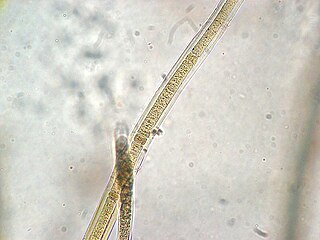
Anabaena is a genus of filamentous cyanobacteria that exist as plankton. They are known for nitrogen-fixing abilities, and they form symbiotic relationships with certain plants, such as the mosquito fern. They are one of four genera of cyanobacteria that produce neurotoxins, which are harmful to local wildlife, as well as farm animals and pets. Production of these neurotoxins is assumed to be an input into its symbiotic relationships, protecting the plant from grazing pressure.

Nostoc is a genus of cyanobacteria found in various environments that forms colonies composed of filaments of moniliform cells in a gelatinous sheath.

Micrasterias is a unicellular green alga of the order Desmidiales. Its species vary in size reaching up to hundreds of microns.

Jean-Baptiste Édouard Bornet was a French botanist. The standard author abbreviation Bornet is used to indicate this person as the author when citing a botanical name.
Nemoderma is the only genus in the family Nemodermataceae and order Nemodermatales of the brown algae. The genus contains only a single species, Nemoderma tingitanum.

Scytonema is a genus of photosynthetic cyanobacteria that contains over 100 species. It grows in filaments that form dark mats. Many species are aquatic and are either free-floating or grow attached to a submerged substrate, while others species grow on terrestrial rocks, wood, soil, or plants. Scytonema is a nitrogen fixer, and can provide fixed nitrogen to the leaves of plants on which it is growing. Some species of Scytonema form a symbiotic relationship with fungi to produce a lichen.
Bangia is an extant genus of division Rhodophyta that grows in marine or freshwater habitats. Bangia has small thalli with rapid growth and high reproductive output, and exhibits behavior characteristic of r-selected species. The plants are attached by down-growing rhizoids, usually in dense purple-black to rust-colored clumps. The chloroplasts of Bangia, like others in the division Rhodophyta, contain chlorophyll a and sometimes chlorophyll d, as well as accessory pigments such as phycobilin pigments and xanthophylls. Depending on the relative proportions of these pigments and the light conditions, the overall color of the plant can range from green to red to purple to grey; however, the red pigment, phycoerythrin, is usually dominant.
Aulosira is a genus of cyanobacteria found in a variety of environmental niches that forms colonies composed of filaments of moniliform cells.
Gymnothamnion is a red alga genus in the family Wrangeliaceae.

Rivularia is a genus of cyanobacteria of the family Rivulariaceae.
The Mesotaeniaceae are a small family of unicellular green algae known as the "saccoderm desmids". The Mesotaeniaceae appear to be sister or ancestral to the Zygnemataceae. The desmids are a deep branching group of Zygnemataceae. Spirotaenia was found to be a basal green alga.

Anderson Lake is a 57-acre (23 ha) body of water lying 1.5 miles (2.4 km) west of Chimacum in Jefferson County, Washington. It is located in Section 9, Township 29N, Range 1W. Anderson Lake reaches a depth of 29 feet (8.8 m) at its deepest point and has a water volume of 1,228 acre feet (1,515,000 m3). The lake drains into Chimacum Creek and Port Townsend Bay. It is surrounded by Anderson Lake State Park. The lake's fish population includes lake-reared rainbow trout, that carry over to a second season from the initial spring fishery.

Thalassionema is a genus of Chromista belonging to the family Thalassionemataceae.
Amorphonostoc is a genus of Cyanobacteria belonging to the family Nostocaceae.
Fischerella is a genus of cyanobacteria belonging to the family Hapalosiphonaceae.
Gloeocapsopsis is a genus of cyanobacteria belonging to the family Chroococcaceae.
Dolichospermum is a genus of cyanobacteria belonging to the family Nostocaceae.







